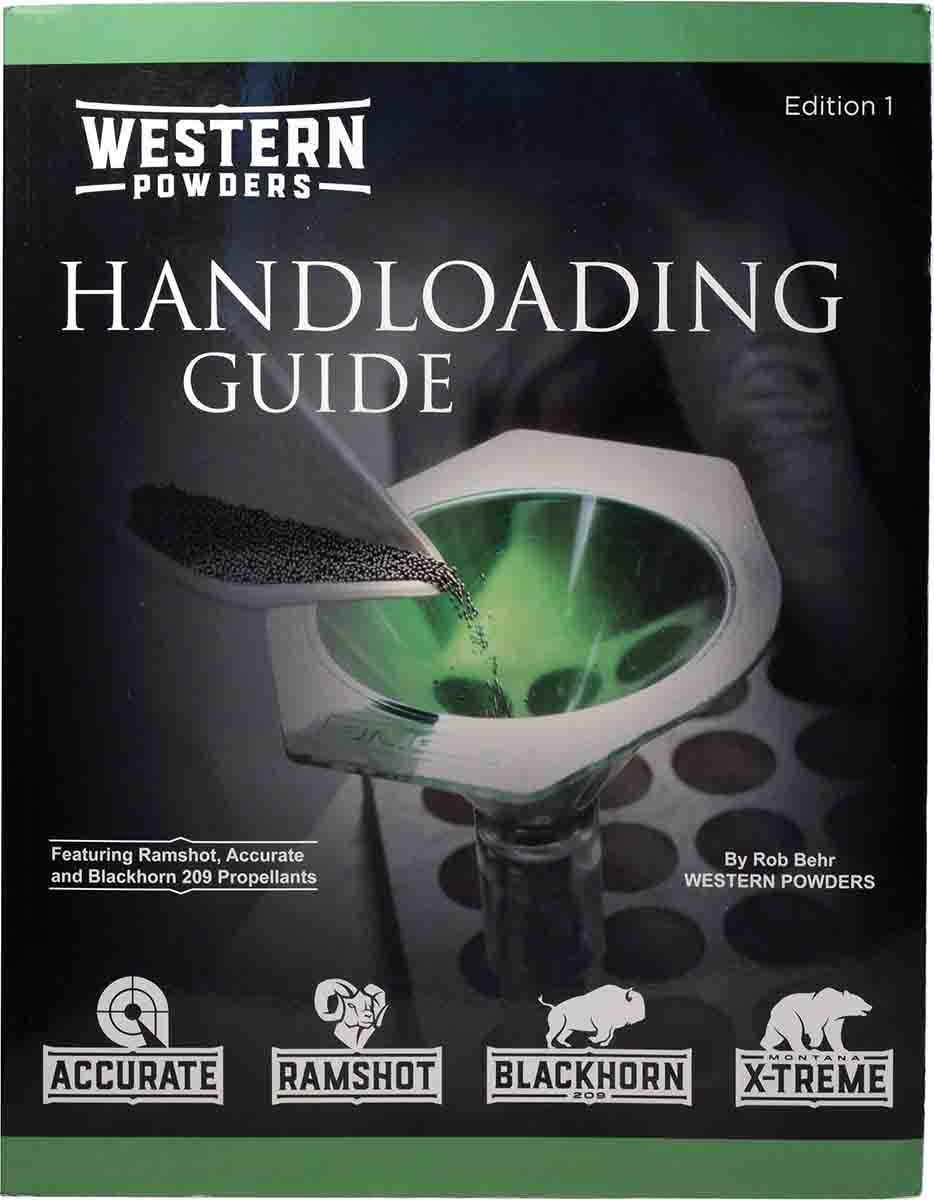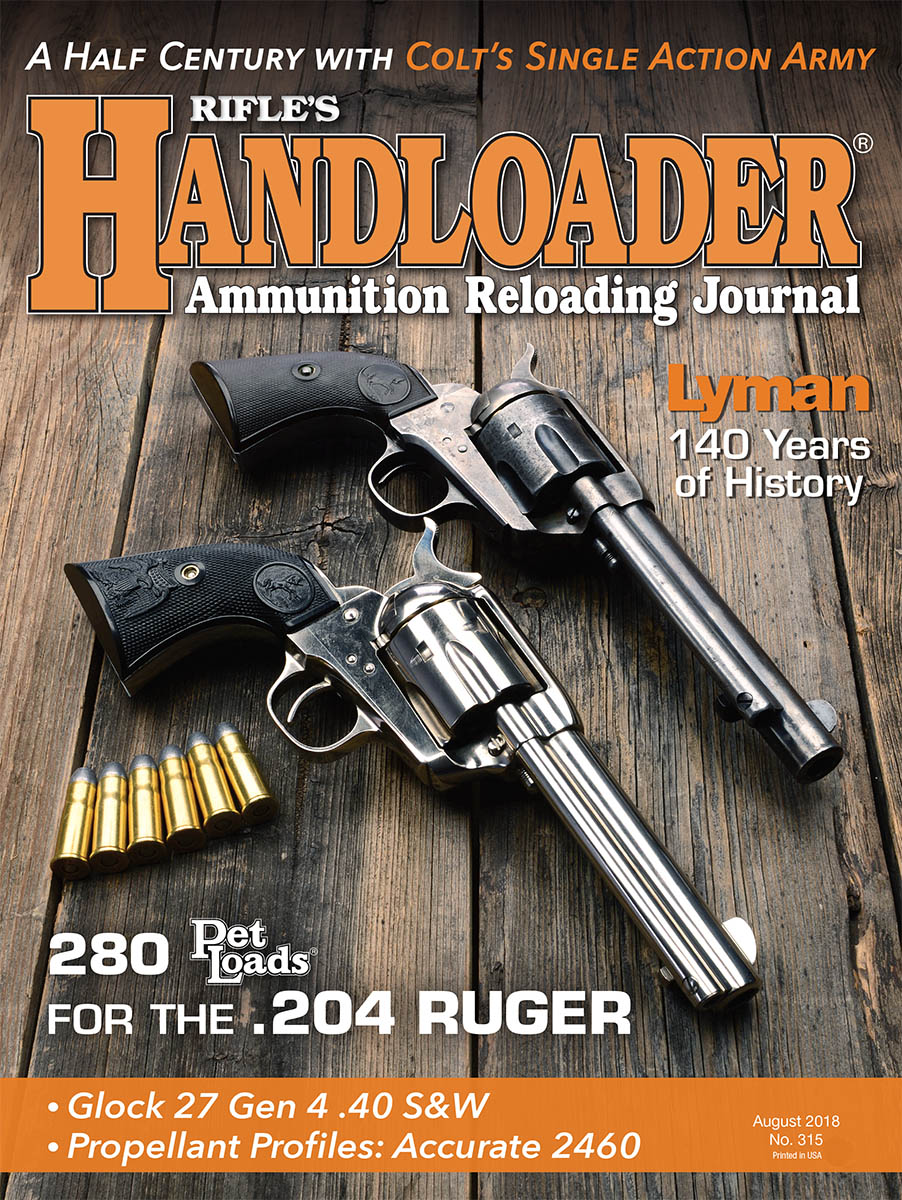Book Reviews
Western Powders Handloading Guide Edition 1
whatsnew By: R.H. VanDenburg, Jr. | August, 18
Those of us who dote on reloading manuals have been waiting patiently for Western Powders to introduce its promised “big book” on reloading. Originally known as Roundup Powders, in 1992 the company moved to Miles City, Montana, and became Western Powders. In 1996 Western began offering its own line of Ramshot canister smokeless powders. Most were purchased from Europe or produced domestically by Primex Technologies, an Olin Corporation spinoff, now a part of General Dynamics and known as St. Marks Powders.
In 2005 Western purchased the smokeless powder division of the Accurate Arms Company and moved it to Miles City. Accurate

The long-awaited “big book” was published in 2017, but deliveries began in early 2018. It is very well done and well worth the wait.
It is 8½ by 11 inches and almost 500 pages in length. It is the work of Rob Behr of Western and printed by Wolfe Publishing Company. The book has soft covers, and every page is of a slick, glossy makeup capable of withstanding most spills. The first 50 pages are devoted to text. A “Table of Contents” and a “Preface” are followed by “Getting Started,” “Reloading Basics” and “Tips, Tricks and Signs of Trouble.” These three sections were taken directly from the Reloading & Load Data Guide, Edition 6.0. Following these are sections on “A Beginner’s Guide to Advanced Handloading Techniques,” “Powder Position and Pressure,” “Give Carbines the Gas,” “Shotshells for Handguns” and “Beware Berdan,” all of which are new. A nice touch is that the page edges are color coded: white for text, blue for handgun, orange for rifle and green for shotgun data.
I always recommend reading the text in new manuals. It serves as a refresher course and often sheds new light on a particular phase of handloading that may be of concern. This book is no different. Read it and enjoy.
Next is the load data for handgun, then rifle cartridges. Much of the data appears in the 6.0 edition, but there is new data, of course, as this book greatly expands on the earlier publication. Western presents its data in a different form than other manuals. Others present data by cartridge, then by bullet weight or ranges of bullet weights, and within them, data for each powder considered. Western presents data by cartridge, then by applicable powders, fastest to slowest, and within each powder, by bullet from lightest to heaviest.
In other manuals I’ve seen several bullets of the same weight, but of different designs, lumped together. I tend to cringe although I accept the data as safe. In the Western data within each powder category, each bullet is specifically identified and has its own range of powder charges, velocities and maximum pressure. Comparing data in the Western method does take longer but seems to be more exact.
For each cartridge there includes text and a cartridge drawing, neither of which appear in earlier Western publications. Also included are specifications of barrel length, bullet diameter, twist rate, case, primer, maximum case length and trim length. In some cases data is presented for more than one pressure level, and the specifications are given for each level. Each data line includes bullet weight (grains), bullet manufacturer, bullet type, start load (grains), start velocity (fps), maximum load (grains), maximum velocity (fps), maximum pressure (psi) and cartridge overall length.
The Handgun section contains data for 61 cartridges from the 5.7x28mm to the .500 Magnum. Where applicable, standard and +P pressure levels are presented as one cartridge. Most are traditional revolver or pistol cartridges offered by major manufacturers. Others may be proprietary, such as the JDJ series or Super Mag cartridges or the 7mm IHMSA or 7mm Merrill. The data for many of these were not developed by Western but obtained from the cartridge designer. Still, there is quite a mix of old and new, including several cartridges resurrected by the Cowboy Action gang. Some of the cartridges include load data for Blackhorn 209, along with cleaning instructions.
Following the Handgun section are chapters on “Handloading with a Chronograph,” “A Look at AR-15 Pistol Performance” and “A Dangerous Mismatch,” which calls attention to the possibility of chambering cartridges not intended to be fired in a particular arm.
The Rifle section includes 139 cartridges from the .17 CCM to the .550 Magnum. There is a broad mix of cartridges from the familiar to the relatively unknown – factory and wildcat. Following the Rifle section is more text including pieces on “Removing Stuck Cases,” ”Finding Twist Rate” and “Barrel Slugging.”
Surprising to those not familiar with Western’s publications is a Shotgun Load Data section. Data is limited to the 2¾-inch, 12 gauge in Winchester, Remington, Federal and Fiocchi target hulls, and to Ramshot Competition, Accurate Nitro 100 NF and Solo 1000 powders. The data is presented by powder, then by hull across the page with columns for shot weight, wad, primer and powder charge (grains) and pressure (psi), in usually 25-fps increments from 1,050, or 1,075, fps to 1,425 or 1,450 fps. Each combination is shown in only those columns where appropriate.
Information follows on Montana X-Treme cleaning products and Blackhorn 209 as well, then a Glossary and a Burn Rate Chart for most popular powder lines.
In the earlier 6.0 edition the right-most column in the load data was for a “comp load,” meaning the maximum powder charge was compressed. A “C” appeared in the column opposite any compressed charge. In the new book no such column exists, but in the page titled “Understanding the Data” that preceeds the Handgun section, it is noted that an asterisk will appear in the Rifle data to identify compressed loads. As far as I can tell, few asterisks appear in this new book, omitting data so designated in previous publications. That’s a shame; I like to know beforehand if a charge is compressed.
There is no list of cartridges with page numbers in the Table of Contents. Since the sequence of cartridges frequently differs from that presented in previous publications, it’s sometimes hard to find a specific cartridge or know if it is included at all. The MSRP is $40 at westernpowders.com.


